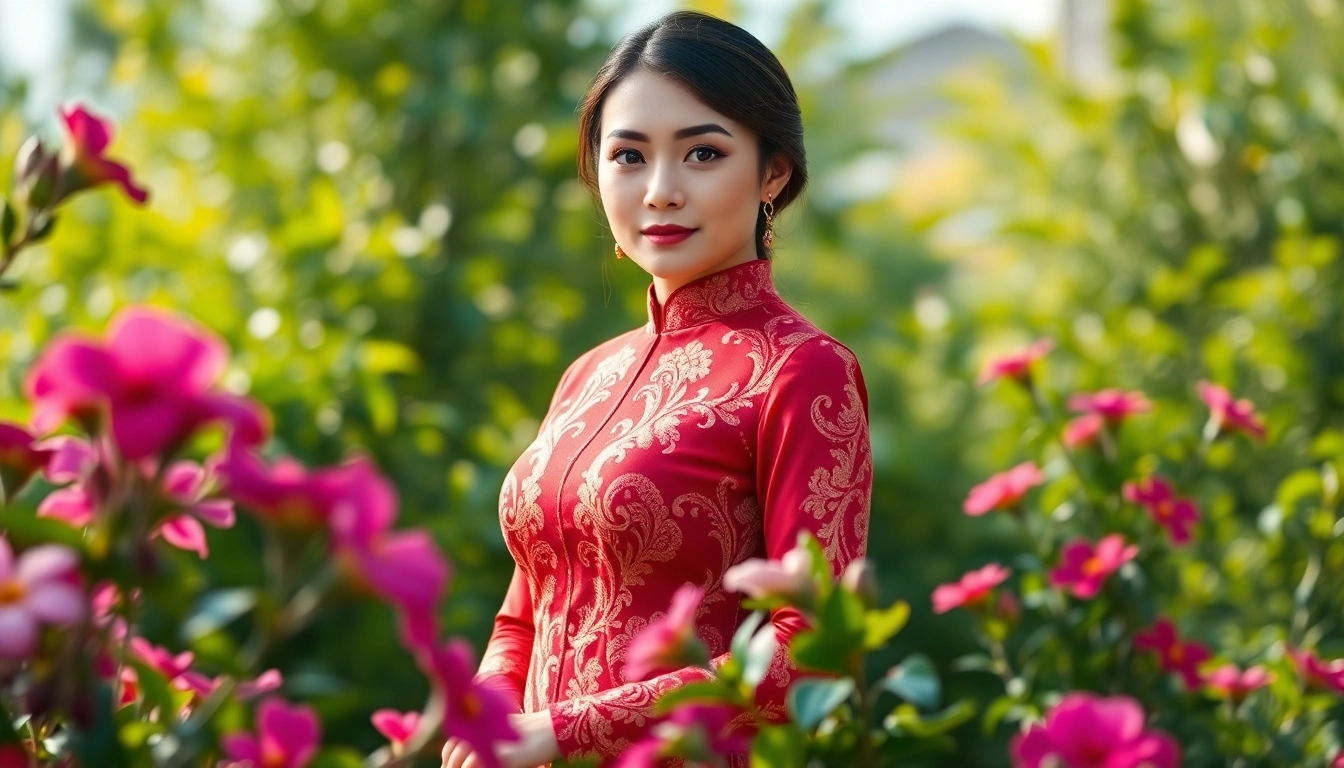Introduction to the Vietnamese Áo Dài
The Vietnamese Áo Dài is more than just a piece of clothing; it is a symbol of the rich cultural identity of Vietnam. Characterized by its elegant silhouette, the Áo Dài has undergone significant transformation while maintaining its connection to Vietnamese traditions. This article delves into the historical background, cultural significance, modern adaptations, traditional designs, styling tips, special occasions for wear, and care methods for this iconic garment.
Historical Background and Evolution
The Áo Dài’s origins can be traced back to the 18th century, evolving from earlier forms of traditional Vietnamese attire. Originally a two-piece garment resembling the modern form, it underwent a notable transformation during the early 20th century. Influenced by Western fashion, the Áo Dài was streamlined, favoring a more form-fitting and elegant design, which became popularized during the colonial era. This transformation marked a significant shift in how Vietnamese culture and dress were perceived, reflecting both national identity and modernity.
Significance in Vietnamese Culture
Integral to Vietnamese cultural identity, the Áo Dài represents beauty, femininity, and grace. Traditionally worn by women, it is often associated with ceremonies, weddings, and national festivities. The garment not only celebrates the wearer’s figure but also projects confidence and poise. Wearing the Áo Dài is a way to honor Vietnamese heritage, as it symbolizes unity and cultural pride. With the rise of nationalism, the Áo Dài has become a powerful emblem of Vietnamese culture, showcasing local craftsmanship and artistry.
Modern Adaptations of the Áo Dài
As society evolves, so too does fashion. The Áo Dài has seen various modern interpretations, often incorporating contemporary elements to appeal to younger generations. Designers now experiment with vibrant colors, innovative fabrics, and innovative cuts, making the Áo Dài accessible for casual wear while retaining its traditional charm. Additionally, many international designers are incorporating elements of the Áo Dài into their collections, further promoting its global recognition. This blend of tradition and modernity showcases the versatility of the garment, bridging the gap between the past and the present.
Traditional Designs and Fabrics
Common Fabrics Used in Áo Dài
Traditionally, the Áo Dài is crafted from various fabrics, each chosen for its texture, drape, and significance. Silk is the most favored material, known for its luxurious feel and cultural importance. Cotton and synthetic textiles are also utilized, especially for more casual designs. Each fabric contributes uniquely to the garment’s appeal; silk provides elegance and fluidity, while cotton offers comfort and practicality. The choice of fabric often reflects the occasion, with silk reserved for formal wear and cotton for everyday use.
Traditional Patterns and Their Meanings
Patterns on the Áo Dài are not merely decorative; they often carry deep meanings. Floral motifs symbolize beauty and nature, while geometric designs represent harmony and balance. Each region of Vietnam often showcases unique motifs that reflect local traditions and environments, adding an additional layer of significance to the garment. For instance, patterns depicting waves are common in coastal regions, highlighting the relationship between the people and their natural surroundings.
Regional Variations in Design
The Áo Dài varies significantly across different regions of Vietnam, reflecting the diverse cultural heritage of the country. Northern designs are often characterized by muted colors and simple elegance, while Southern styles tend to be bolder, favoring bright colors and intricate patterns. Central Vietnam is known for its unique embroidery styles and elaborate designs, which often tell local myths and stories. These regional variations contribute to a rich tapestry of cultural expression, making the Áo Dài a uniquely Vietnamese treasure.
Styling the Vietnamese Áo Dài
Choosing the Right Fit
A well-tailored Áo Dài enhances the wearer’s figure and comfort. When choosing the right fit, consider your body shape and size. The garment should follow the natural curves of the body without being overly tight. Many experts recommend opting for slightly looser designs, as they provide ease of movement while still looking polished. It’s essential to try different styles, as each may suit different body types and personal preferences.
Accessorizing for Special Occasions
Accessorizing the Áo Dài can elevate its overall appearance and personalize your look. Common accessories include elegant jewelry, such as pearl earrings or gold necklaces, that complement the neckline of the dress. Additionally, traditional conical hats (nón lá) or delicate silk scarves can add a layer of sophistication and authenticity. Footwear, such as elegant sandals or traditional slippers, is also crucial in completing the look—aim for styles that match the color scheme and tone of the Áo Dài.
Step-by-Step Styling Tips
To achieve a polished look with the Áo Dài, follow these styling tips:
- Choose the Right Size: Ensure the Áo Dài fits well; it should skim your silhouette without being constricting.
- Layer Wisely: If layering is necessary, opt for lightweight materials that won’t add bulk.
- Keep Accessories Minimal: Let the dress be the statement piece—opt for simple, elegant accessories.
- Pay Attention to Footwear: Select shoes that complement the style and occasion; traditional sandals work for formal events.
- Experiment with Hairstyles: Traditional hairstyles like a simple bun or flowing locks can enhance the elegance of the Áo Dài.
Occasions to Wear the Áo Dài
Weddings and Formal Events
The Áo Dài is the quintessential attire for Vietnamese weddings and formal occasions. Brides often wear elaborately designed Áo Dài with intricate embroidery and embellishments, symbolizing beauty and grace on their special day. Guests are also encouraged to don this traditional attire, showcasing their respect for the couple and their culture. In formal settings, the Áo Dài represents decorum and sophistication, making it an appropriate choice for events such as galas and awards ceremonies.
Cultural Festivals and Celebrations
Cultural festivals, such as Tết (Lunar New Year) and the Mid-Autumn Festival, are occasions where the Áo Dài shines brightly. During Tết, families often wear matching Áo Dài, symbolizing unity and joy. The vibrancy of colors and designs reflects the festive spirit, while the garment serves as a reminder of strong familial ties and cultural roots. These celebrations not only promote the wear of the Áo Dài but also serve as a platform for showcasing traditional Vietnamese culture and values to the world.
Everyday Wear and Fashion Trends
Though the Áo Dài is often reserved for special occasions, it is increasingly embraced as everyday wear. Modern interpretations of the garment are making it versatile and functional for daily life. Designers incorporate comfortable, breathable fabrics, allowing for ease of movement. The trend of wearing the Áo Dài casually, particularly among younger generations, signifies a blend of tradition and contemporary style, making it accessible and fashionable at various social settings.
Care and Maintenance of the Áo Dài
Cleaning and Storing Your Áo Dài
Proper care and maintenance are essential for preserving the beauty of your Áo Dài. Hand washing in cool water with mild detergent is recommended for silk fabrics, avoiding harsh chemicals that could damage the fibers. After washing, hang the garment to air dry in the shade, as direct sunlight can fade the colors. When storing, fold the Áo Dài carefully to prevent creases and avoid using hangers that may stretch the fabric. Keep the garment in a breathable garment bag to protect it from dust and pests.
Repairing Common Damage
Despite careful handling, wear and tear may occur over time. Common issues include loose stitching, minor rips, or fabric pilling. For minor repairs, learning basic sewing techniques can be beneficial—repairing small tears with needle and thread can extend the garment’s life significantly. For more serious damage, consulting a professional tailor who specializes in traditional clothing is recommended to ensure repairs are executed cleanly and subtly.
Preserving the Beauty of the Fabric
To maintain the longevity of the Áo Dài, regular care is crucial. Always follow the fabric care instructions associated with your garment, and avoid wearing it too frequently to prevent fabric fatigue. Protect the garment from exposure to makeup, perfume, and other chemicals that could result in stains. Additionally, consider periodically using a fabric-safe conditioner to retain its softness, thus preserving the luxurious feel that is characteristic of high-quality Áo Dài.




